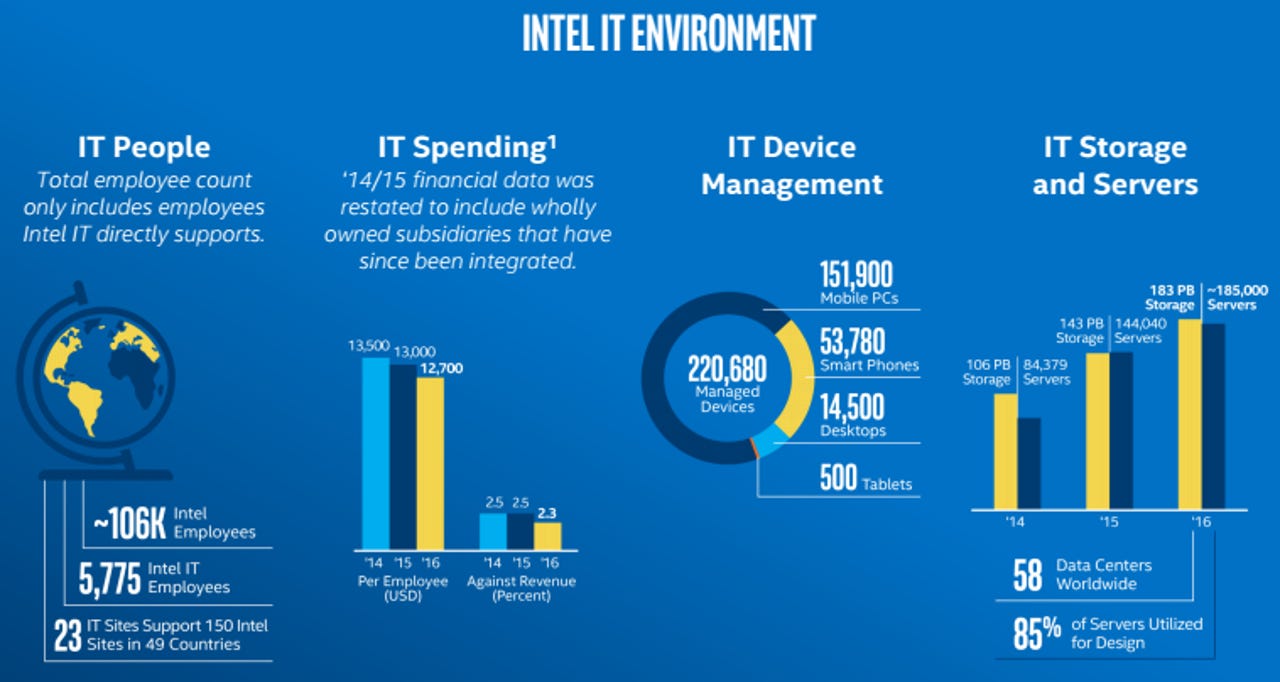Intel showcases its technology with its own digital transformation story

Intel on Wednesday released its IT annual performance report, showcasing how its own technology is helping the company modernize its operations.
Focusing largely on Intel's use of machine learning, the report highlights the $656 million in business value Intel gained from deploying predictive analytics across the company. Additionally, Intel's use of machine learning during the product design phase has helped bring Intel products to market faster by 39 weeks. The report also highlights how, using its own disaggregated servers, Intel is saving about $1 million a year by cutting server refresh costs by as much as 65 percent. And using Intel's collaboration software Unite, the company has saved 50,000 hours of employee worktime.
"You cannot really spell 'digital transformation' without using IA," or Intel architecture, joked
Burges Karkaria, CTO of Marketing and Customer Experience for Intel IT. Karkaria had another tagline for the report's focus on machine learning: "AI works best with IA."
More seriously, he said, "While we are building the products shaping the future of digital transformation, we are going through our own digital transformation within Intel as well. As an IT organization, we obviously have the core responsibilities of running the business, but within Intel's organization we have an additional responsibility of being an early adopter, putting some of [Intel's] technologies into practice."

Across the organization, Intel's IT needs reflect a challenge that just about every enterprise has: growing compute and storage needs that must be met with a roughly flat budget. The company has 185,000 servers providing 183 petabytes of storage.
Intel realized $656 million in business value from predictive analytics after investing in big data years ago, Karkaria said. The company uses a big data stack based on Cloudera, Karkaria said, declining to name any other vendors Intel uses. The company uses a great deal of proprietary technology built on machine learning and deep learning techniques.
"It takes time to start laying the foundation and extracting the first bits of business value" out of these investments, Karkaria said. "It does take a lot of senior management understanding and support to keep a slightly longer life cycle to achieve the benefits of this compared to many other efforts."
The annual report also highlights the $500 million in revenue Intel says it generated by "unifying" the customer experience, with the help of big data and machine learning. Intel analyzed its own sales and marketing data along with public information about its customers to build sales strategies "that helped their true needs," Karkaria said.
This was especially significant, given the changing goals of Intel's customers. While Intel has traditionally served many different verticals that were once relatively isolated, that's no longer the case. "Someone building an IoT solution is also building an automotive solution, and so on and so forth," he explained.
The report also highlights aspects of Intel's digital transformation that are characteristic to manufacturing. As the world's largest chipmaker, Intel has factories bursting with data. It's used IoT sensors and big data analysis to collect and process 5 billion data points per day, per factory. With all of the information that's quickly processed, the company has increased uptime and accelerated output at its factories.
Intel also laid out an IoT framework for more efficient shipping and warehousing. It also uses drones and Intel RealSense technology to track and inspect inventory. Its automated inventory management systems delivered $121 million in business value and enabled Intel to reduce its pipeline (the amount of inventory effectively sitting on shelves) by more than 12 percent.